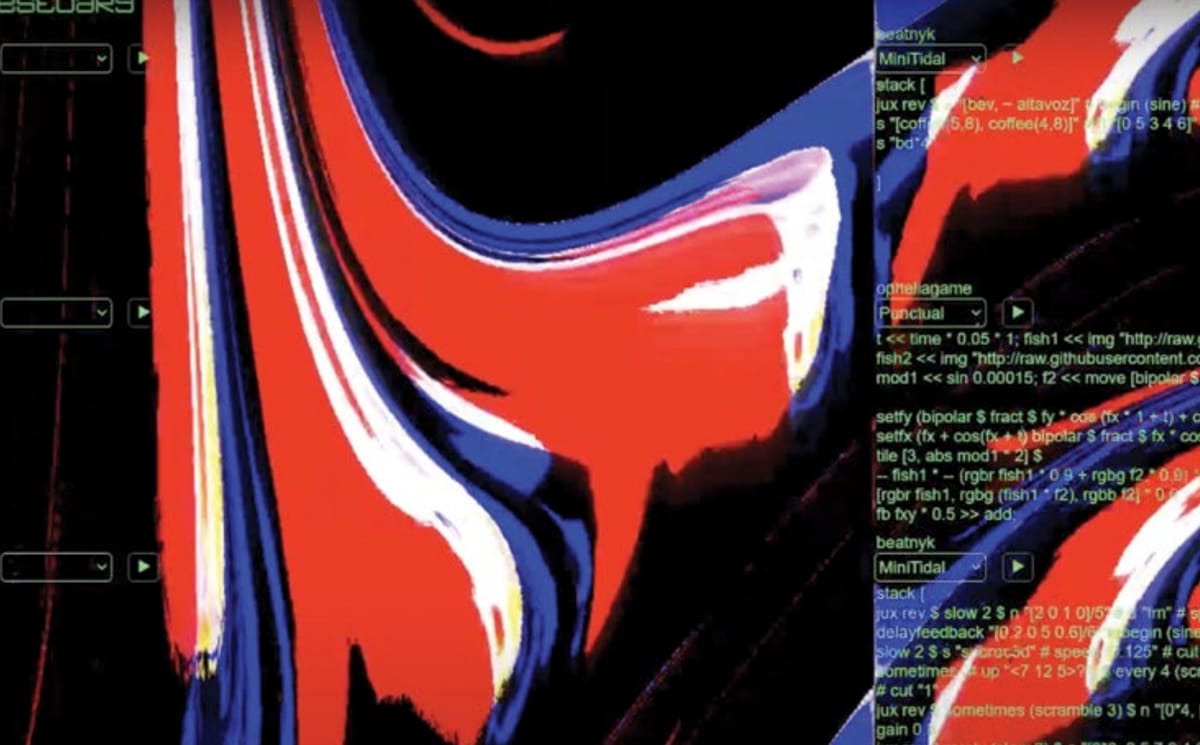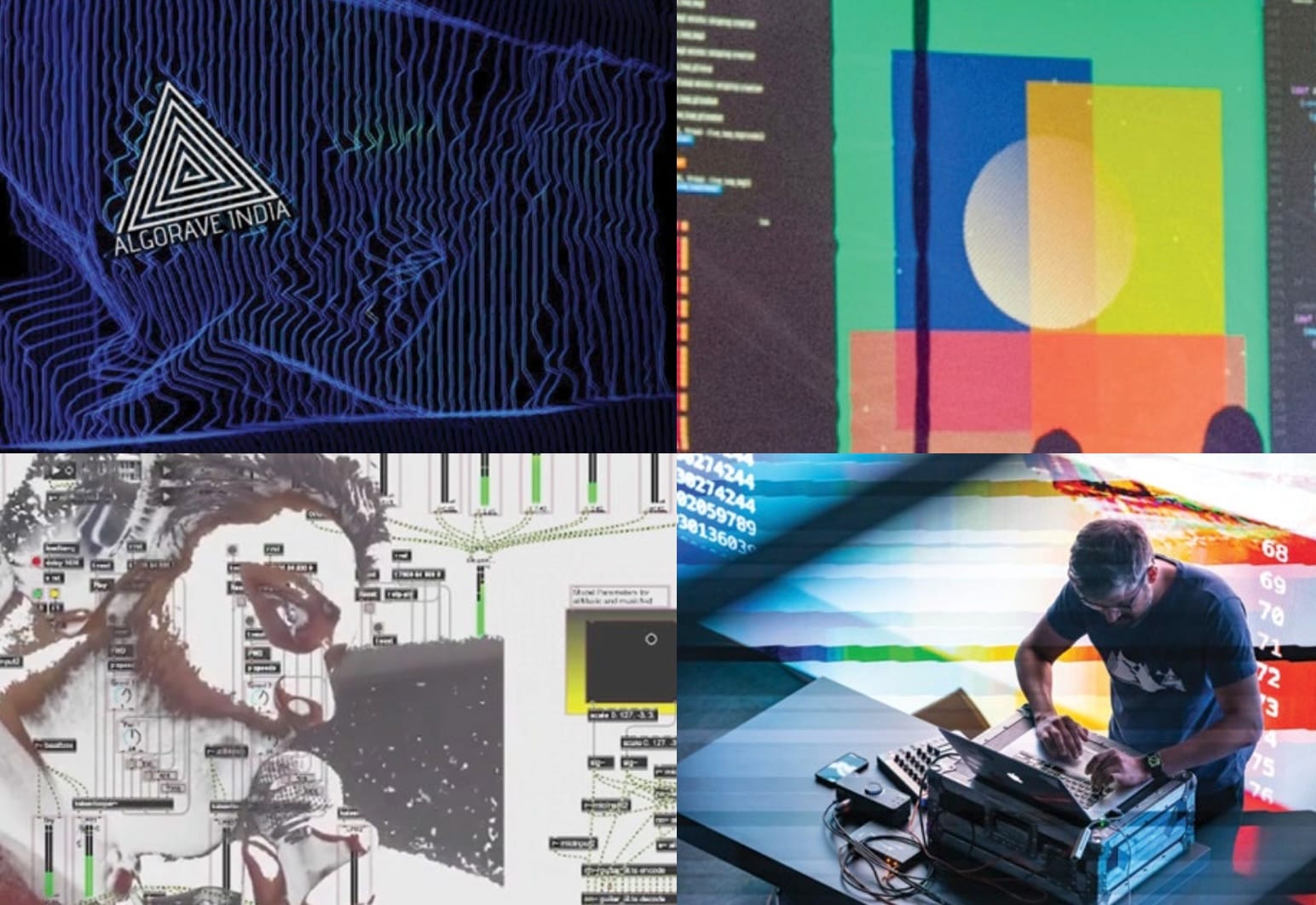“Show us your screens”: Algorave and the radical joy of live coding
Prarthana traces algorave’s sonic manifesto and its defiant call: make the code public, make the culture shared, and make the dance floor political again.

By Prarthana Mitra
The message on the wall, a deceptively simple call to unhide what’s on our screens, reads almost like a command for the “Big Daddy Mainframe” of surveillance tech (which would make this a rather odd provocation to introduce in an anthology about/against digital power). But it’s really more of a commandment to resist technological black-boxing, and its origins lie in the open-source live coding community.
A burgeoning global counterculture movement against tech obscurantism, algorave — short for algorithmic rave — involves writing code to make live music (or other time-based art like visuals or choreography). This form of creative labour is not only taking dance music back to its radical roots but also powering a critical questioning of the Big Tech industrial complex through a performance of something that’s typically inscrutable — the code.
If we look back at Synchromy, a short film made by Norman McLaren in 1971, we encounter something of a prototype for elaborate and self-reflexive multidisciplinary approaches to interrogate and interact with the structure constituents that make, well, life. In Synchromy, McLaren makes sound visible by taking apart the apparatuses of audiovisual production and breaking them into units of light, colour, shape and rhythm.
In 2004, an emerging crop of internet artists in Sheffield in the United Kingdom did something similar. They were led by Alex McLean, who had the foresight to pre-emptively address what has now emerged as critical pain points in computational tech regulation and accountability — namely, the black-boxing and gatekeeping of code and data. They introduced a form of sound art performance that, as the independent magazine The Wire put it, is “all about getting into the guts of how music is made, showing code running in real time, taking machines and systems apart to show their workings, and opening up technologies to alternative uses”.
Precisely because technological systems produce paranoid subjects out of us by controlling and restricting the information we get, the TOPLAP manifesto and Live Coding: A User’s Manual — two documents that have fuelled the algorave movement — both emphasise the need to make algorithms visible in order to better understand, subvert, reappropriate and play with them. And play they did, bringing together live coding enthusiasts from across the world to computer music parties, design sprints and hackathons. These became spaces where hacker philosophy, geek culture and clubbing collapsed, each with varied manifestations of its own but still organising themselves around the same central philosophies. What emerges is the paradigm of a participant-audience.

An overlooked but pivotal aspect of algorave is the centrality of collaboration, likely a natural extension of the movement’s championing of open-source technologies like TidalCycles, Sonic Pi, SuperCollider and p5.js. Whether it’s decolonising technology, technology education or electronic dance music, it must all begin with decolonising the software, and the way these programming instruments are used to build communities of practice. These musicians recognised that.
In the twenty-five years since it came into being, the algorave movement has brought together and encouraged hundreds of musicians, artists and researchers to start their own dedicated nodes and instigators across the global majority today. These creators are now taking and interpreting this vision for democratising access and knowledge to tinker with code in their own contexts. These nodes are not only connected to each other through virtual showcases and exchanges but have also each made great strides in incubating young artists in their respective contexts. As a result, the sounds of algorave today encompass a range of styles: from minimal techno and live-coded ragas to “cinging” (coding + singing). But no matter how much they differ, all these styles are unified in the calculated rawness of their transmissions.
The Global South boasts a diverse and growing community of algorave performers and live coding enthusiasts, instigated by Algorave India’s Abhinay Khoparzi, Akash Sharma, Dhanya Pilo and Joshua Thomas, Pakistan-based Karachi Community Radio’s Jahanzeb Safder, Indonesia’s Rangga Purnima Ajji, Argentina’s Iris Saladino and Colombia’s Alexandra Cardenas — to cite a few — all with unique contours and agendas framed by the digital landscape in their respective contexts. Their sets are strewn with digital artefacts that are singular to each location and the artist’s own identity: hyperlocal memes and news footage, musical instruments and sounds, even topographical references like ‘estuary sessions’ — all play the dual role of relatability and representation.
Challenging what critic Hubert Adjei-Kontoh describes in The Baffler as the “defanged, neatly packaged identity politics of dance music”, algorave builds liminal spaces which allows anyone with a laptop and a fundamental understanding of computational processes to make music. Importantly, it also educates and empowers the audience to become an active participant in bearing witness to the making of an audio story.
When it comes to representation in algorave, the practice of live coding as a means of expression and resistance is, to a great extent, still restricted to urban centres. This is especially true in a country like India, where access to the internet, hardware and a community is still prescribed by power imbalance and systemic inequalities. But recent trends — particularly owing to mass curiosity and awareness around generative AI and readily accessible tools — portend to the mainstreaming of algorave in the future.
Allahabad-based Khoparzi, one of the earliest algoravers from India, recognised the merit in situating the movement in India as an art collective that promotes programming as a performance art. Founded in 2018, Algorave India has since evolved into a “strategy for community development, music education, computational literacy”. Several promoters are now using it as a pedagogical tool and making great strides towards leveraging creative coding’s potential to start important conversations, particularly among data workers and STEM aspirants about the possibilities of open-source tech, the advantage of multidisciplinary approaches in coding practice, and the real-world implications of the black-boxed technologies they’re trained to build/refine/test.
The work to meaningfully centre the most marginalised, surveilled and othered bodies in this movement has begun with the sprouting of, for example, women’s coding collectives like Ajaibghar. Based out of Rajasthan, Ajaibghar artists like Ambika Joshi, Nanditi Khilnani and Anushka Trivedi explore emotional experiences, motherhood and self-care through generative music, poetry and art. They also provide space for women to participate in creative computation through initiatives like Coding with Friends. The now-defunct Coven Code — which comprised many algoravers based out of New Delhi — was also set up to onboard and orient more women and gender diverse people into live coding, create safer dance floors for women, and reclaim technology. There is much resonance with the VNS Matrix, which emerged from the Cyberfeminist Manifesto to “hijack the toys from technocowboys and remap cyberculture with a feminist bent”.
In its liberatory playfulness, algorave transcends “reimagination” as merely a discourse and actually reimagines another world that may exist within the paradigm of Donna Haraway’s “polymorphous information system” — a concept that describes a flexible, interconnected network of humans, machines and meanings, where boundaries are blurred and multiple realities can coexist. At the same time, it is still able to abandon the master’s [proprietory] tools in lieu of open tech systems. Like with any counterculture, algorave, too, thrives on volunteers and vanguards who form an ecosystem. In India, art curators, F/LOSS (Free/Libre and Open Source Software) communities, sound artists, AR/VR studios, programmers and design practitioners are all collectively conceiving new and contextually rooted ways of bringing a (b)rave new world into being. They do this by primarily changing the conditions under which art and algorithms come into meaning. As audience-participants, we can only bring our curiosities and openness — to bear witness, to keep the code running.
Prarthana (they/them) is interested in exploring third spaces through their feminist research and creative communications practice at the intersection of bodies, tech and justice. A 2024 DRAPAC Fellow, Prarthana’s work in the digital rights space has involved organising digital communities of practice and designing campaigns, games and interventions around gendered disinformation, platform accountability and decolonial AI. Prarthana has also written on policy and culture, particularly audio practices in South Asia, for Wild City, Gaysi and Border Movement. Currently, they are building a digital project around chronic disabilities out of Goa, India.
Join one of the following groups and we'll keep you in the loop, including sending you a copy of the digital version of the first issue of Balance.
Join Signal Group | Join Whatsapp Group | Join Telegram Group




